
I have many homes. I lived in Flushing for 14 years and have lived in Little Neck for over 17 now. I went to school on the Bedford Stuyvesant-Clinton Hill border for 4 years and in Brooklyn Heights for five, where I also worked. I worked in Turtle Bay for eight years, Port Washington for twelve. But my original home was Bay Ridge and I lived there in a variety of locales for over 30 years in three locations; I’ll count my year in Dyker Heights there, close enough. Though Bay Ridge isn’t the Irish-Italian-Scandinavian enclave it was when I started out I still feel at home whenever I go even though my favorite eateries, Zeke’s Roast Beef and Nathan’s, are long gone. Today, I lunched at Pizza Wagon, a Bay Ridge fixture since 1966. To say it’s old school is an insult to old schools. Let’s say you go for the pizza, not the ambience.
In June 2024, in nearly perfect shooting conditions and low humidity, I was able to execute a walk of several miles in Bay Ridge. My plan was to concentrate on the one-block streets in the western part (which will wind up on their own page) and then walk Third Avenue (I haven’t done that since a post-heart surgery walk in 2007) and Fifth, winding up at the N train on 8th and 62nd. Since then, an increasingly sensitive back has forced me to keep my walks to 3 or 4 miles. To think I walked 3rd Avenue from Shore Road to Flatbush Avenue two months after a valve replacement! Those were the days…
This will likely be a two-part special, if not three.
GOOGLE MAP: BAY RIDGE WALK 2024
The New Bay Ridge Avenue Station
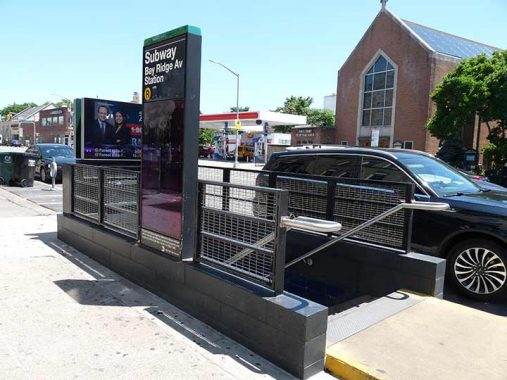
I began at the Bay Ridge Avenue station at “69th Street” (as Bay Ridgers call it) and 4th Avenue. This is one of a number of stations on the BMT 4th Avenue line that received a complete makeover in 2017, with new message boards, wi-fi and artwork. While these improvements won’t improve performance on weekends, when there can be 20 minutes between R trains, they’re a welcome change. Katy Fischer’s “Strata” is a particularly handsome piece of Pollock-esque art.
The Emphasis Diner on 4th Avenue and Bay Ridge Avenue (69th Street) is in a propitious spot because it’s the first thing weary commuters from work in Manhattan see upon climbing the steps from the mugger-mover. Many moons ago, the Emphasis was the site of our postgame show on one of Forgotten NY’s Bay Ridge tours. (I remember on the first one, which took a good five hours to complete, we wound up at the Bridgeview on 3rd Avenue and 92nd.)
Here’s a photo of Ed Koch, NYC mayor from 1978-1990, crossing 4th Avenue in front of what would eventually be the Emphasis. (The guy to his left looks like Richard Dawson, but it can’t be him.) This must have been during or after one of Bay Ridge’s parades; my guess is the Ragamuffin Parade, which takes place in the fall. Ed once sat near me at a screening for a film version of Sharon Seitz and Stuart Miller’s The Other Islands of New York City. He was quite tall, so I was glad he didn’t pick the seat right in front of me.
Here’s where my memory fails me. The old man often mentioned eating at Joe Major’s, 6814 4th Avenue, seen here on the right. It closed many years ago, so I know little about it (Bay Ridge oldtimers, hit me up in Comments). Was the restauranteur named Joe Major? Anyway, I always thought the Emphasis occupied the building home to Joe Major’s. It didn’t. It did take the place of a diner, but the other one in the photo, the New Royal, which shows up in 1940s tax photos. The Emphasis is in the low building on the left as well as the taller one to its left, out of the photo.
Joe Major’s remains one of Bay Ridge’s longtime restaurants I never made it into. We did frequent the Green Tea Room (I was perplexed whether the tea was green or the room), The Tiffany Diner on 99th Street and the Scandia on 3rd Avenue, and probably others I have forgotten. I lived across the expressway from New Corner on 8th Avenue and 72nd, but, alas, never went in.
The Gothic Bay Ridge High School on 4th between 67th and Senator Streets was built in 1913 and served under that name, in its later years an all-girls’ public high school, until 1985, when it became the High School of Telecommunication Arts and Technology. Amazingly, it isn’t landmarked. Among Bay Ridge High School’s early alumnae was Hollywood silent era “It Girl” Clara Bow; basketball’s Taj Gibson graduated from Telecommunication Arts.
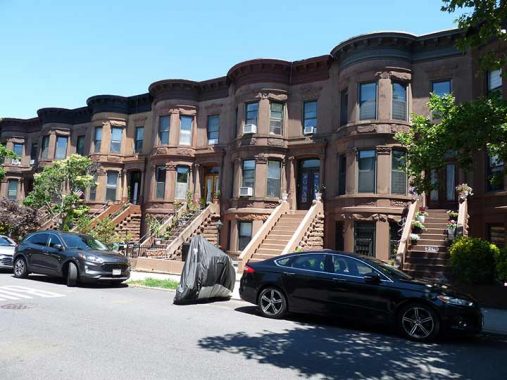
On 67th Street between 3rd and 4th, the bread and butter of western and central Brooklyn residential architecture, the attached brownstone.

At 68th Street and 3rd Avenue, Three Jolly Pigeons has held down the corner ever since I rode on the B37 bus to A & S with my parents in the 1960s. Even in the 40s, the bar on the corner was bird-themed, “Vogel’s.” “III JP’s” claims to be one of Brooklyn’s longest consecutively operating pubs in Brooklyn, dating all the way to 1906.
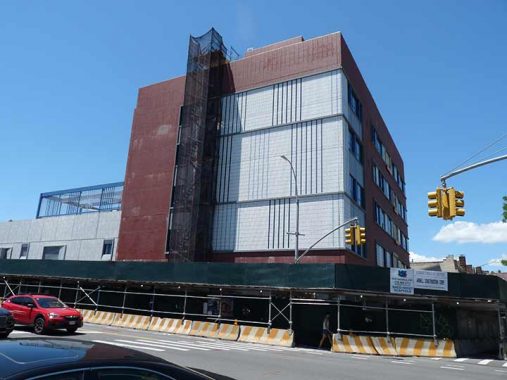
The new P.S. 413 Joanne Seminara School of Law & Medicine, 280 Senator Street at 3rd Avenue, resembles a prison…
A green oasis in 2024, Steadman Square, 3rd Avenue and Senator Street, is something of a curiosity as 3rd Avenue grows a curving “limb” filled with trees and grass. It was the terminus for the Third Avenue Trolley line until the late 1950s, when buses replaced the City’s trolley service. Thereafter, the site was transformed into the triangle’s present form.
There’s a connection between Steadman Square and the Confraternity of the Most Precious Blood, a few miles away at Fort Hamilton Parkway and 53rd Street. The parcel honors Monsignor Joseph F. Steadman (1896-1946). In the course of his life, Monsignor Steadman served as a chaplain, directed three churches in Queens and Brooklyn and wrote several religious missals (books containing the readings and prayers for each Roman Catholic Mass or prayer service) still in use throughout the world.
At FHP and 53rd Street there is a massive nunnery, the Sister Adorers of the Precious Blood (sounds like an organization J.R.R. Tolkein — a Catholic himself — would conceive of), which established in 1861 in St. Hyacinthe, Quebec and came to the United States and to Brooklyn in 1890 at the request of Bishop John Loughlin (of Bishop Loughlin High School fame). Their present building there was constructed from 1905-1910. Beginning in 1925 the order was under the leadership of St. Francis College graduate Father Joseph Stedman, who elevated it to prominence by publishing a massive array of Catholic-themed books under the Church imprimatur labeled Confraternity of the Precious Blood, including missals and philosophical treatises. At the time of his death, it was noted that more than 13,000,000 copies of his books had been sold. Fr. Stedman died at the youthful age of 49.
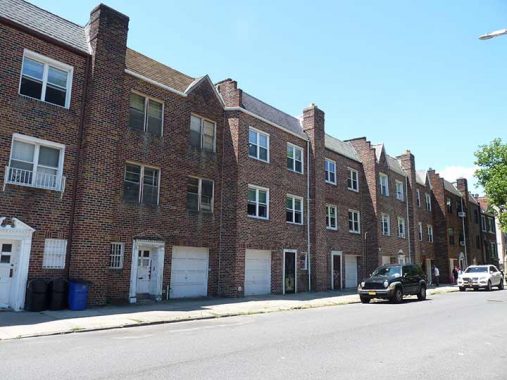
These attached brick homes appeared on Senator Street mid-century, sporting that new contrivance, the auto garage.
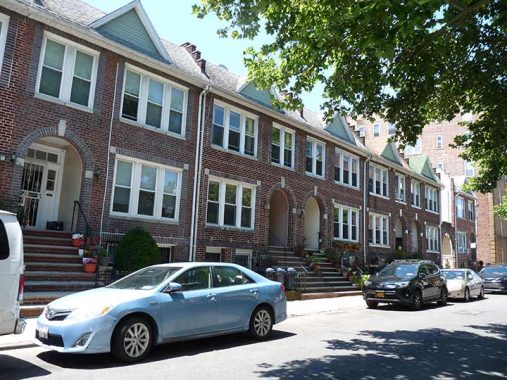
A little further west is a similar grouping, without first floor garages.
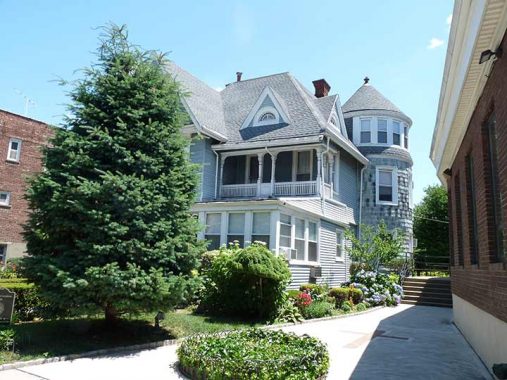
Early in the 20th Century, 1st and 2nd Avenues were renamed “Colonial Road” and “Ridge Boulevard” to lend a more suburban attitude. Modern-day politicians, meanwhile, are all about density, and intend to build more units on smaller plots.
This Queen Anne-style house, just past Senator Street, is the parish house for the St. Andrew the Apostle Catholic Church (founded in 1971; obviously a private residence was purchased for it). The church itself consists of a brick ground floor constructed around a pre-existing corner house in 1981. The parish was formed when the Bay Ridge Towers on 65th Street between 3rd and 4th Avenues was completed in 1971, overwhelming the pre-existing Our Lady of Angels (4th Avenue and 73rd Street) parish.
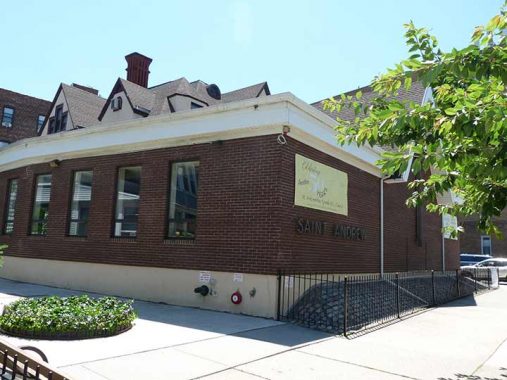
In the New Testament, Andrew was the brother of Simon Peter and shared his profession, fishing. According to tradition he shared the fate of Jesus Christ and Peter, that of crucifixion. Not considering himself worthy to be crucified on the T-shaped cross used for the Christ, he requested an X-shaped cross, today known as “St. Andrews’ Cross.” Such X-shaped crosses were included in the architecture of Manhattan’s st. Andrew’s Church at Foley Square.
This magnificent Art Deco apartment building at Ridge Boulevard and 67th Street boasts an angle. It’s following a bend in Ridge Boulevard, the same bend that all north-south Bay Ridge Avenues take at 67th. In the late 1800s, 7th Avenue was laid out at a diagonal against the overall Brooklyn street grid south of 65th Street, and its brother avenues take an angle to remain parallel with it. I have an intriguing (OK, to me, at least) Beers Atlas of the town of New Utrecht from 1873, and it shows just a few streets traversing through what would be Bay Ridge. 3rd and 4th Avenues are already established, but 86th Street and 7th Avenue are just ghost lines.
As for the building itself, it features intricate brickwork and plenty of right angles in the facade.
Kateri Tekakwitha (1656-1690) was the first Native American to be canonized as a saint. The Mohawk was born in central area of what is now New York State. In brief: Her conversion to Christianity and vow of chastity at age 19 was unpopular with her parents; she subsequently traveled to a community of Mohawks near what is now Montreal. Fatally devout, her self-denial and fasting made her sickly and she died at age 24.
The front yard at the St. Andrew’s parish house has been registered as a Saint Kateri Habitat. The Saint Kateri Habitat Program encourages Catholics and Catholic entities to restore and protect habitat on their property, at home and in their communities.
Bergen and Sedgwick
Wherever you go in NYC, no matter what the overall neighborhood demographic, there’s a Dutchman looking over your shoulder. “Bergen” and “Sedgwick” are frequent street names hereabouts. Bergen Place, only one block and much shorter than Brooklyn’s Bergen Street and Bergen Avenue, was named for Teunis Bergen (1806-1881), town supervisor of the Town of New Utrecht, of which Bay Ridge was once a part. It’s a tidy, shady, tree-lined block with a notable apartment house from the early 20th Century.
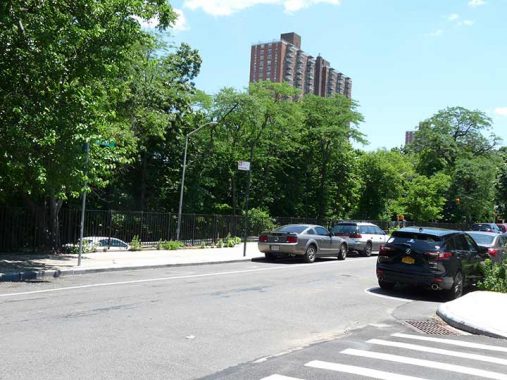
Wakeman Place is another little-known named (as opposed to numbered) Bay Ridge route. Abram Wakeman was a postmaster, politician and financier who helped build the Bay Ridge and Manhattan Beach Long Island Rail Road lines, whose tracks can be found just east of the Belt Parkway from Wakeman Place.
A Belt Parkway off ramp is located at Wakeman Place and Ridge Boulevard, and well into the 1990s, a short-masted “Woody” parkway pole was hanging on here; though it vanished by 2000.
Bergen Place’s partner, Sedgwick Place, features several handsome freestanding houses. Theodore Sedgwick was a founder of Bay Ridge’s Christ Church (while the much longer Sedgwick avenue in the Bronx was named for a Civil War general).
Street name origins from Brooklyn By Name, Benardo/Weiss
Owl’s Head Park is a green oasis on a hill overlooking the Narrows, with views of Staten Island and the Verrazzano Bridge. No one is sure how the park got its name, though it’s speculated that the gateposts of an estate belonging to a senator (State senator Henry Cruse Murphy, of Senator Street fame) who lived in the area, which sported a pair of carven owls’ heads. The parcel also belonged to an industrialist named Eliaphet Bliss, whose mansion was rudely removed by Robert Moses in 1940. When I was a kid, old-timers still called it Bliss Park. Ex-Brooklynite and former Fiery Furnace Eleanor Friedberger wrote the first song about Owl’s Head Park that I know of, and it’s affecting.
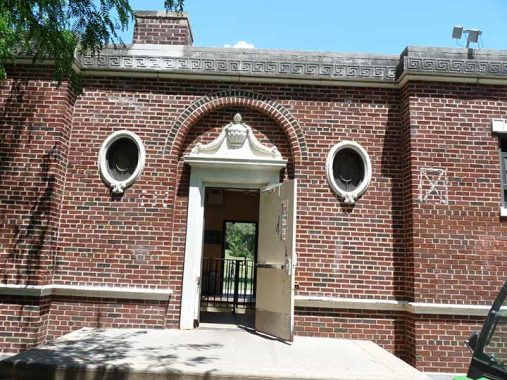
The park has a nice Georgian, oval-windowed restroom house, of which I took advantage.
Knowing little about Spanish cuisine, I never ventured into Casa Pepe, #114 Bay Ridge Avenue near Colonial Road; though it closed in 2019, its building and illuminated sign are still perfectly preserved, six years later.
From here, I bounced around to a few of Bay Ridge’s one-block “Places.” (You can see my route on the linked Google Map above.) I am going to skip those on this page because I want to use them for a series I have shamefully let go fallow that I began at the start of 2024: “One and Done,” an examination of NYC’s one-block streets. Lower Manhattan was fairly easy, but there are a lot of them in the other boroughs. I hope I have time to complete the series.
I set off south on 3rd Avenue from Bay Ridge Avenue, which has numerous interesting sidewalk storefront signs that would pique James and Karla Murray’s interest. Cosentino’s Fish Market has served Bay Ridge foir the better part of a century, on 3rd Avenue between 69th and Ovington, since the 1920s. I have three iterations of their sidewalk sign: from 1940, about 2000, and, after the moved across the street, 2024. The new sign is a modernized version of its immediate predecessor, green (a different shade), sanserif lettering and a picture of a fish.
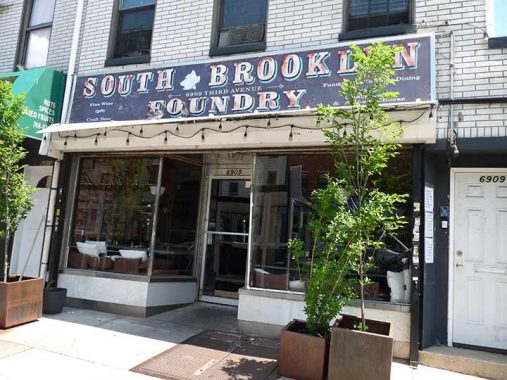
I’ve noticed a new trend in storefront signage: distressed lettering to add authenticity. The trend was on full display at South Brooklyn Foundry, which unfortunately had recently closed by the time I passed by.
Throughout its tenure, South Brooklyn Foundry became a community hub, hosting events ranging from jazz and drag shows to paint-and-sip nights. However, like the rest of the hospitality industry, South Brooklyn Foundry struggled to stay afloat once the COVID-19 pandemic started. [Brooklyn Paper]
An appearance on Gordon Ramsey’s “Kitchen Nightmares” was unable to solve the restaurant’s internal problems, as its two founders couldn’t settle on an overall philosophy.
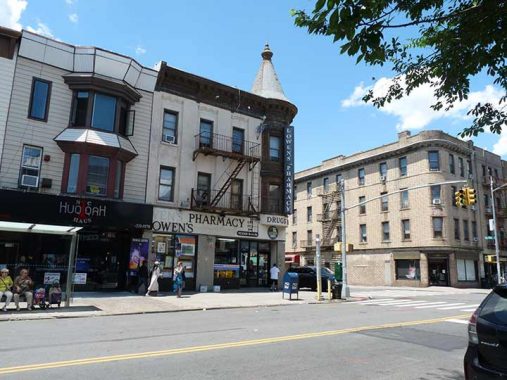
The peaked building with the rounded edge at the SW corner of 3rd Avenue and Bay Ridge Avenue (69th Street) has been home to a pharmacy on the ground floor for apparently most of its life, today’s Lowen’s; my friend Brian Merlis at brooklynpix has a photo from 1913, when it harbored Wolff’s. Much of the detailing on the corner turret is unchanged, but the sidewalk sign has undergone some unfortunate changes of late. Paul Lukas has the scoop at Inconspicuous Consumption (which may be paywalled; I’m a subscriber).
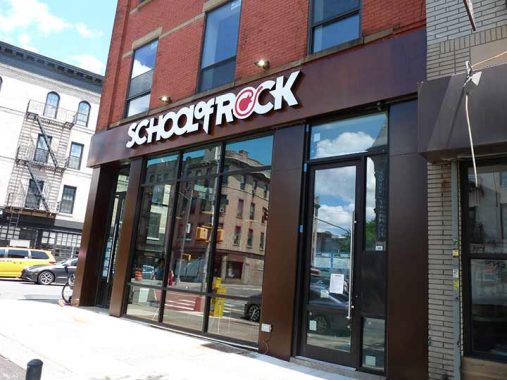

Just across the street on the corner, I remember it for Circles Cafe, which also had a second location about 22 blocks south at 91st Street; both had closed by 2019, to be replaced with School of Rock, which is exactly what the sign says it is. Various Schools of Rock were named after the 2003 Jack Black vehicle in which he plays a music teacher. (Castmate Mike White went on to helm the much-praised “White Lotus” TV series.)
The Brooklyn Firefly and its classic neon sidewalk sign are on the corner of 3rd and Ovington; the Firefly is a sitdown restaurant pizzeria/concert venue. The space had previously been occupied by Yellow Hook Grille, named for Bay Ridge’s former moniker that was doomed by an outbreak of yellow fever, and before that, the pizzeria Lento’s.
The old Bay Ridge Theatre, on 3rd Avenue and 72nd Street, is now home to a McD’s, a Rite Aid drugstore, and Harbor Fitness on the third floor. Reportedly, some of the old theatre furnishings are still there in the gym. Hubert Selby, author of “Last Exit to Brooklyn”, grew up across the street. Another theater, the Electra, was at 3rd and Bay Ridge Parkway (75th Street): the building is now a supermarket. The theatre was open from 1915 through 1959. A photo from the old days is at cinematreasures.
Bennett Court
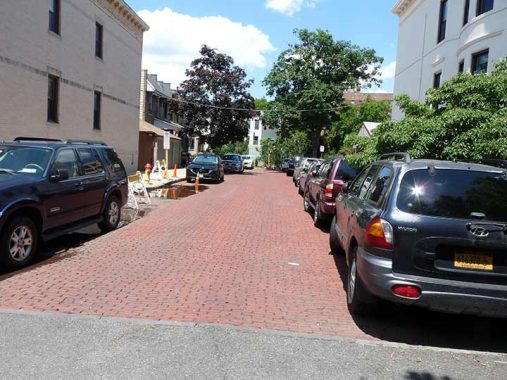
When I’m in these parts, I always meander down 72nd Street between 3rd and 4th Avenues to see how Bennett Court’s luxuriant red brick roadbed is holding up, one of NYC’s few remaining such. It is one of two cul-de-sacs on 72nd Street near 4th Avenue. Ovington Avenue bends to avoid a now-vanished pool, which gave developers room to build the two alleys here.
Unfortunately, I was met by a Guardian, one of the local homeowners who questioned my activities here. In these situations I have had increasingly little patience and give as much as I get. My philosophy is if homeowners want to keep people out of their cul-de-sacs, get the city to install a gate and a lock; cf. Macdougal Alley and Grove Court in Greenwich Village.

I spotted this venerable sign for the Metropolitan Society of Kardamylians at #7919. According to its website, the [o]rganization’s activities consist of “receiving and collecting funds for charitable and educational purposes, as well as inculcating in its members the traditions, history and customs of the ancestral home, Kardamyla and assure the continuance of the educational process of the history of Kardamyla.”
I had never figured Bay Ridge a premier Greek neighborhood; when I was a boy there, its inhabitants were mostly Irish and Scandinavian, with some Italians and Syrians mixed in. Today, immigrants from all over the Middle East have arrived. Kardamyli is a town at the southern tip of Greece and is the same town mentioned by Homer in The Iliad, when Agamemnon bargains with Achilles to join his forces against Troy, offering him the town as part of tribute. The town is known for its beaches and medieval relics.
My eye was drawn to its classic plastic-lettered sign which must be several decades old; why change it– it gets the job done. It’s rendered in Century Schoolbook Bold (including the Greek language words), with the house number in Helvetica. The medallion on the left shows the prow of a Greek warship during the Trojan War era, and “Kardamyli” in Greek capitals.
Skipping south a few blocks, this pair of furious blue eyes at 3rd Avenue and 80th Street caught mine. Immediately recognizable as Frank Sinatra, this portrait was executed by talented Argentinian street artist Andreas Iglesia (Cobre) with assistance from Jenna Morello. Iglesia has executed the largest portrait in the western hemisphere, of soccer superstar Lionel Messi holding the World Cup, located in Santa Fe, Argentina.
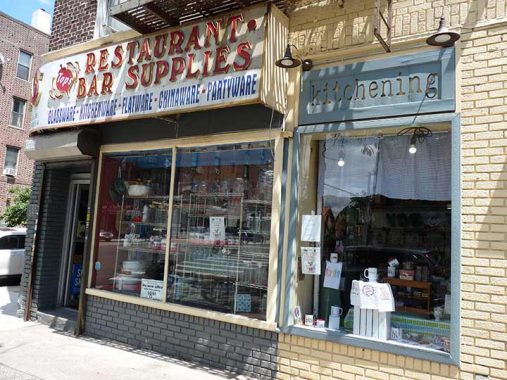
We’re about to enter a thicket of interesting sidewalk signs. As luck would have it, the Sinatra portrait is on the same building as this fantastic plastic-lettered sign for Tops Restaurant and Bar Supplies. Sorry to say, even though I worked for type houses for years, I know the font but can’t remember the name. Help me in Comments!
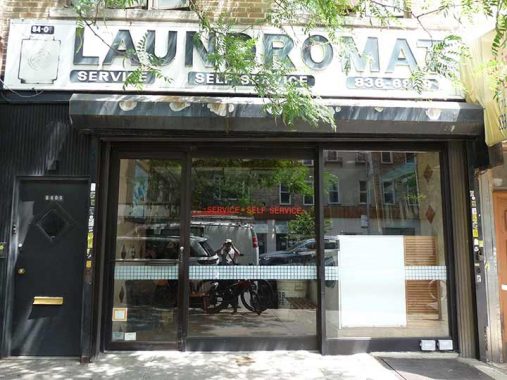
#8409 3rd Avenue. Laundromat signs interest me, because many just stay there for decades; I know of one on 86th Street and Battery Avenue whose letters fell off one by one, until by the time it closed, two or three were left.
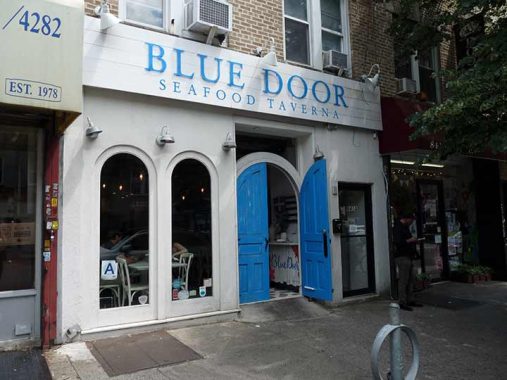
Just two doors down is Blue Door seafood restaurant which indeed have a blue door, in my favorite blue shade, no less, and the restaurant is spelled out in my favorite font, a variant of Garamond.
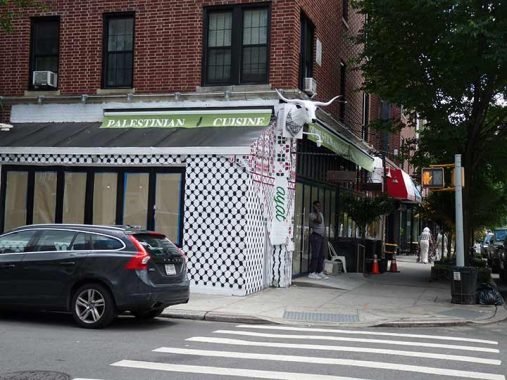
You can literally take the bull by the horns on the corner of 3rd and 85th at Palestinian restaurant, Ayat. Mediterranean and Greek cuisine is among the world’s healthiest.
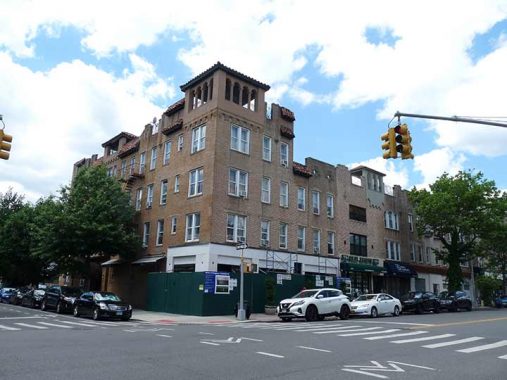
I lived in Bay Ridge from 1957-1993 and always wondered if the open-air courtyard on this corner turret on the apartment building at 3rd and 85th was open to residents, if they had keys; or is it unkempt and full of pigeon droppings? Once again, if you know the story, Comments are open.
This neon liquor store sign at #308 has been here a long time; it may have been here when I was a kid, before I began noticing neon liquor store signs. Yes indeed, the 1940 tax photo displays a McKee Liquors sign.

The simpler and more boldly colored the sign the better. Would like to know the story behind the name of Ten Cake Studio at #8617 3rd Avenue since obviously, more than ten are produced at this custom cake confectionery.
Me, I have to mostly stay away from cakes or I’ll get the diabeetus.
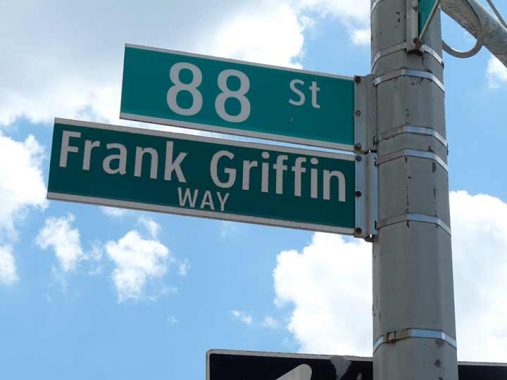
For many years, southwest Brooklyn had two local newspapers, the Brooklyn Home Reporter and Brooklyn Spectator. Frank Griffin founded the Home Reporter in 1956, which absorbed the Spectator in 1976. Nevertheless, the two papers were published separately, albeit with similar content. In the 1980s, other papers such as Bay Ridge Paper, a branch of the Brooklyn Paper, joined the fray. Today, the Reporter, as it is now known, is published online by the Vicky Schnepps organization. Griffin passed away in 2011, and the Home Reporter offices at 3rd Avenue and 88th is now an eye doctor’s office.
Though the traditional color that O’Brien (shown here) and newer, more streamlined Dresser hydrants is black with a silver crown, locals sometimes paint them in brilliant colors, including their occasional protective bollards. O’Brien hydrants have been part of NYC’s streetscape since 1906, making them older than “ice cream cone” fire alarms!
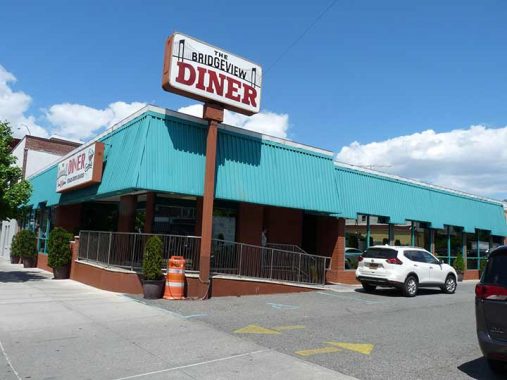
After detouring to 4th Avenue and 90th Street to get new snaps of Forest Place for that “One and Done” page I was talking about, it was back to 3rd Avenue to check on the Bridgeview Diner. At a time when diners are disappearing the Bridgeview is persisting. It was the site of the postgame show for FNY’s Bay Ridge tour in 2013, the second of two, the first coming in 2005. Both were five-hour shoe leather specials!
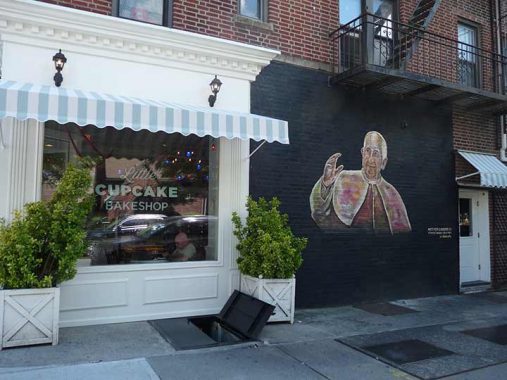
As I’ve said, I have to stay away from cake shops such as the Little Cupcake Bake Shop at 3rd Avenue and 91st Street, but the portrait of Argentinian prelate Jorge Mario Bergoglio, known to the world as Pope Francis since 2013. He is the first Pope from the Western Hemisphere and first Jesuit to helm the Holy See.
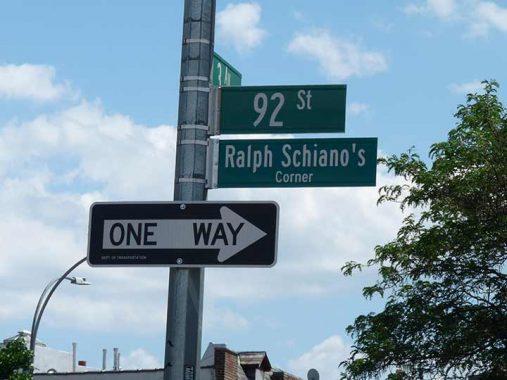
Ralph Schiano was the longtime owner of Marine Market (named for the avenue) until its closure in 2017. Schiano has since passed away, and he received this tribute street sign in 2023.
Another entry in the new Distressed Sign trend is Henry Harde’s Wines and Liquors. If you look closely, the claim is “est. 1933” and its 1940 tax photo does show a liquor store.
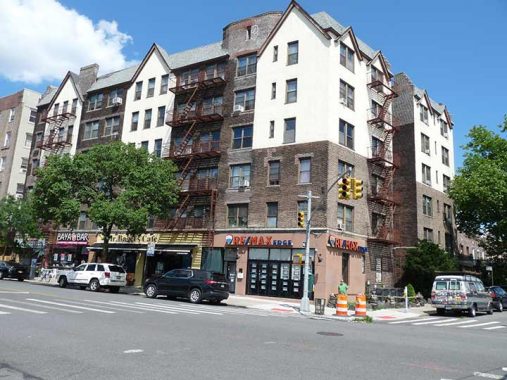
You can’t see it too well here, but this incredible apartment building at 3rd and 95th has a great lawn fence, with stone pillars and wooden logs. In the Swingin’ Sixties and later, the ground floor had a camera shop the old man frequented. The Tudor elements of its early days have gradually been eased off.

I remember The Wicked Monk better as Ballybunion (named for a town in Ireland) which it was for several decades. My bicycle was stolen on 95th Street one night while I was hoisting with friends inside, and the family met here for a meal during dinner hour at wakes (see below). There was a Wicked Monk on 5th Avenue and 84th Street nearby, so it likely took over the location.
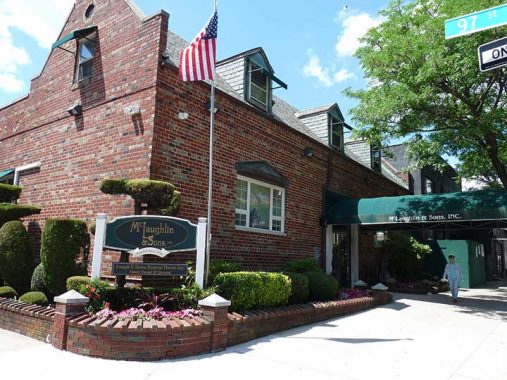
Actually I’ve spent a lot of time in funeral homes, while still upright. Greater Astoria Historical Society had its office in the Quinn Funeral Home (now out of business) for many years. My mother was waked here in 1974, so when my father passed in 2003 I dialed McLaughlin’s, 3rd Avenue and 97th Street, right away. Most funeral homes are located in impressive buildings, but try finding building histories on funeral home websites!
I’ll kick it in the head for now and resume on 5th Avenue next time…
Check out the ForgottenBook, take a look at the gift shop. As always, “comment…as you see fit.” I earn a small payment when you click on any ad on the site.
3/9/25


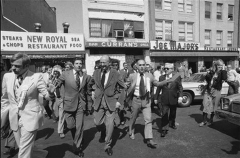
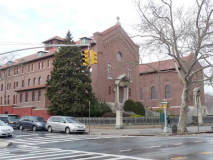
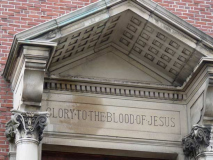



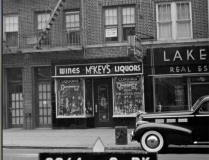
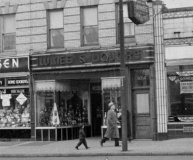
8 comments
My stomping grounds for sure!
Thanks for the article and all the great photos!
I have a fabulous photo I took of the mural of Pope Francis on the corner of 3rd Ave and 91 St ( across from the
Lutheran Church
If you would like I will send you a copy
Neilhunt@aol.com
You mention Steadman Square as the terminus of Third Avenue trolleys. There was a ramp at that location that allowed the cars to climb up to the Fifth Av Elevated Terminal at 65th St. The structure, without tracks, was in place until long after the trolleys stopped using the ramp but I don’t know when it was torn down.
Yes the Wicked Monk changed locations several years ago. It was jjust a bar now it’s a bar restaurant; and the food is good. A friend of mine is a chef there. Also they have more room for live music now.
Owl’s Head Park was the go-to destination for sleigh riding back in the 50’s. You should have snapped a photo of the Bay Ridge Hospital (or whatever it is now) on Ovington Avenue where I was born in 1948.
https://forgotten-ny.com/2007/06/ovington-avenue-and-the-plight-of-bay-ridges-green-church/
It’s no surprise that South Brooklyn Foundry closed. Only about 20% of the restaurants featured on Kitchen Nightmares survived, according to most sources.
If Bennett Ct is a city street tell the “guardian” to kiss your ass. And if it is a private court tell them, like you did, put up a gate with signage letting us commoners know were’ not welcome.
Kevin,
Thanks as always entertaining.
Gerry